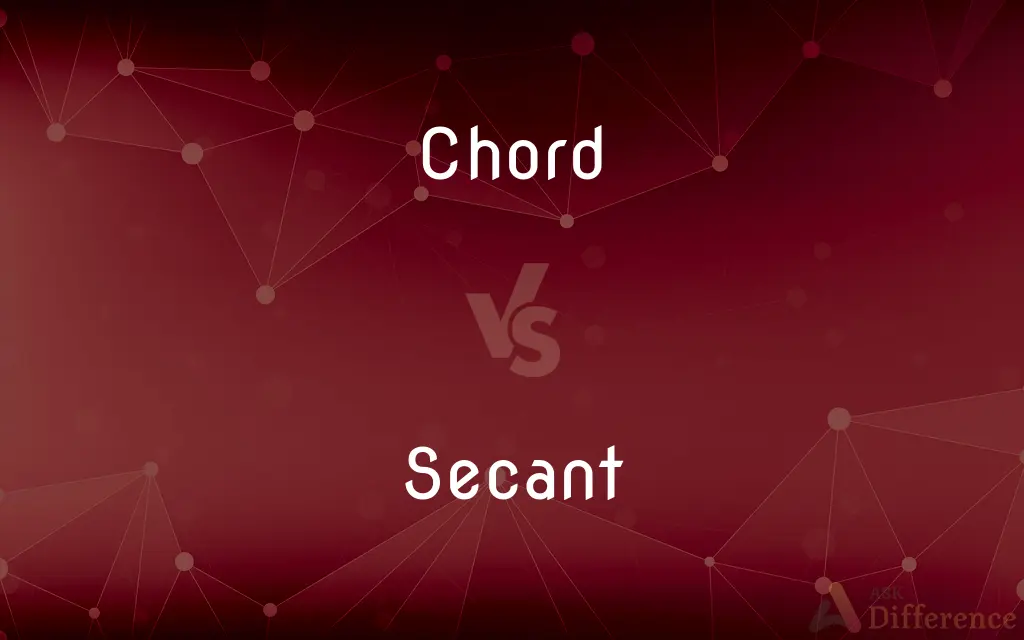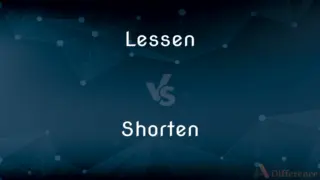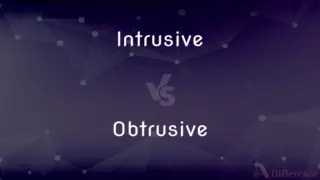Chord vs. Secant — What's the Difference?
By Tayyaba Rehman & Maham Liaqat — Updated on March 28, 2024
A chord connects two points on a circle's circumference, while a secant extends beyond, intersecting the circle at two points.

Difference Between Chord and Secant
Table of Contents
ADVERTISEMENT
Key Differences
A chord is a straight line segment whose endpoints lie on the circumference of a circle. It represents the maximum distance between two points on the circle's edge without leaving the circle's boundary. Whereas a secant is also a straight line that intersects a circle at two points, but it extends infinitely beyond the circle's circumference, highlighting the difference in their lengths and positions relative to a circle.
Chords are entirely contained within a circle, suggesting their finite nature and specific relation to the circle's radius and diameter. On the other hand, a secant's infinite length means it can intersect the circle and continue beyond it, emphasizing its role in connecting and extending past the circle's boundary.
In geometry, the chord plays a crucial role in defining and understanding properties related to the circle's interior, such as arc lengths and circle sectors. A secant, however, is often used in broader contexts, such as in trigonometry and calculus, to explore relationships between circles and external lines or shapes.
One interesting property of a chord is that its length can be calculated using the circle's radius and the central angle it subtends. In contrast, the secant's relationship with the circle is more complex, involving external angles and distances.
Chords and secants both serve as foundational elements in geometric constructions and proofs. However, their distinct definitions and properties highlight different aspects of circle geometry and its applications in various fields of mathematics.
ADVERTISEMENT
Comparison Chart
Definition
A line segment with both endpoints on a circle's circumference.
A line that intersects a circle at two points and extends infinitely.
Length
Finite, can be measured within the circle.
Infinite, as it extends beyond the circle.
Position
Entirely contained within the circle.
Passes through the circle, extending outside it.
Role in Geometry
Important for determining properties within the circle.
Used to explore external relationships involving the circle.
Calculation
Length can be related to the radius and central angle.
Involves more complex relationships with the circle's geometry.
Compare with Definitions
Chord
A line segment within a circle.
The length of a chord can be calculated if the radius of the circle is known.
Secant
Forms external angles.
The angles formed by a secant and a tangent have specific properties.
Chord
Can be a diameter.
The longest chord of a circle is its diameter.
Secant
Used in trigonometry and calculus.
Secants are instrumental in defining trigonometric functions.
Chord
Ends on the circle's circumference.
Any chord of the circle divides it into two arcs.
Secant
Extends beyond the circle.
A secant line can be used to connect two circles.
Chord
Used in circle geometry.
Chords are crucial for constructing and understanding circle sectors.
Secant
Not contained by the circle.
The secant passes through the circle, extending infinitely in both directions.
Chord
Varies in length.
The lengths of chords increase as they approach the center of the circle.
Secant
A line intersecting a circle at two points.
The secant of a circle creates two points of intersection.
Chord
(Music) A combination of three or more pitches sounded simultaneously.
Secant
A straight line intersecting a curve at two or more points.
Chord
Harmony, as of color.
Secant
The straight line drawn from the center through one end of a circular arc and intersecting the tangent to the other end of the arc.
Chord
A line segment that joins two points on a curve. See Usage Note at chord1.
Secant
The ratio of the length of this line to the length of the radius of the circle.
Chord
A straight line connecting the leading and trailing edges of an airfoil.
Secant
The reciprocal of the cosine of an angle in a right triangle.
Chord
(Anatomy) Variant of cord.
Secant
(geometry) A straight line that intersects a curve at two or more points.
Chord
An emotional feeling or response
Her words struck a sympathetic chord in her audience.
Secant
(trigonometry) In a right triangle, the reciprocal of the cosine of an angle. Symbol: sec Category:en:Trigonometric functions
Chord
(Archaic) The string of a musical instrument.
Secant
That cuts or divides.
Chord
(Music) To play chords
She chorded up and down the neck of the guitar.
Secant
Cutting; dividing into two parts; as, a secant line.
Chord
To play chords on
Chorded the piano.
Secant
A line that cuts another; especially, a straight line cutting a curve in two or more points.
Chord
To produce by playing musical chords; harmonize
Chord a melody.
Secant
A right line drawn from the center of a circle through one end of a circular arc, and terminated by a tangent drawn from the other end; the number expressing the ratio of this line to the radius of the circle. See Trigonometrical function, under Function.
Chord
(music) A harmonic set of three or more notes that is heard as if sounding simultaneously.
Secant
A straight line that intersects a curve at two or more points
Chord
(geometry) A straight line between two points of a curve. Category:en:Shapes
Secant
Ratio of the hypotenuse to the adjacent side of a right-angled triangle
Chord
(engineering) A horizontal member of a truss.
Chord
(rail) A section of subsidiary railway track that interconnects two primary tracks that cross at different levels, to permit traffic to flow between them.
Chord
(aeronautics) The distance between the leading and trailing edge of a wing, measured in the direction of the normal airflow.
Chord
(nautical) An imaginary line from the luff of a sail to its leech.
Chord
(computing) A keyboard shortcut that involves two or more distinct keypresses, such as Ctrl+M followed by P.
Chord
The string of a musical instrument.
Chord
(anatomy) A cord.
Chord
(graph theory) An edge that is not part of a cycle but connects two vertices of the cycle.
Chord
(transitive) To write chords for.
Chord
(music) To accord; to harmonize together.
This note chords with that one.
Chord
(transitive) To provide with musical chords or strings; to string; to tune.
Chord
The string of a musical instrument.
Chord
A combination of tones simultaneously performed, producing more or less perfect harmony, as, the common chord.
Chord
A right line uniting the extremities of the arc of a circle or curve.
Chord
The upper or lower part of a truss, usually horizontal, resisting compression or tension.
Chord
To provide with musical chords or strings; to string; to tune.
When Jubal struck the chorded shell.
Even the solitary old pine tree chords his harp.
Chord
To accord; to harmonize together; as, this note chords with that.
Chord
A straight line connecting two points on a curve
Chord
A combination of three or more notes that blend harmoniously when sounded together
Chord
Play chords on (a string instrument)
Chord
Bring into consonance, harmony, or accord while making music or singing
Common Curiosities
How does a secant differ from a chord?
A secant extends infinitely beyond the circle's circumference, intersecting it at two points, unlike a chord, which is contained within the circle.
How is the length of a chord determined?
The length of a chord can be determined using the circle's radius and the central angle it subtends.
Can a chord be a diameter?
Yes, the longest chord of a circle is its diameter.
Do chords vary in length?
Yes, chords vary in length, depending on their proximity to the circle's center.
What is a chord in geometry?
A chord is a line segment with both endpoints on the circumference of a circle.
What is the significance of a secant in mathematics?
Secants are significant in trigonometry and calculus for exploring external relationships involving circles.
What role do chords play in geometry?
Chords are essential for defining and calculating properties within a circle, such as arc lengths.
Do secants form angles with circles?
Yes, secants form external angles when they intersect a circle, which have specific geometric properties.
Is a secant line always straight?
Yes, a secant is a straight line that intersects a circle at two points.
Are all diameters chords?
Yes, all diameters are chords, but they are the longest possible chords in a circle.
Can the properties of a secant be calculated?
Yes, but the calculations involve more complex geometric and trigonometric relationships than those for chords.
How does the position of a chord within a circle affect its length?
The closer a chord is to the center of the circle, the longer it will be, up to the length of the diameter.
How can a secant affect two circles?
A secant line can intersect and connect two circles, creating points of intersection on each.
Can a secant be used in circle constructions?
Yes, secants are used in geometric constructions and proofs involving circles and external lines.
What distinguishes a secant in trigonometry?
In trigonometry, a secant line's relationship with a circle helps define certain trigonometric functions.
Share Your Discovery

Previous Comparison
Lessen vs. Shorten
Next Comparison
Intrusive vs. ObtrusiveAuthor Spotlight
Written by
Tayyaba RehmanTayyaba Rehman is a distinguished writer, currently serving as a primary contributor to askdifference.com. As a researcher in semantics and etymology, Tayyaba's passion for the complexity of languages and their distinctions has found a perfect home on the platform. Tayyaba delves into the intricacies of language, distinguishing between commonly confused words and phrases, thereby providing clarity for readers worldwide.
Co-written by
Maham Liaqat













































